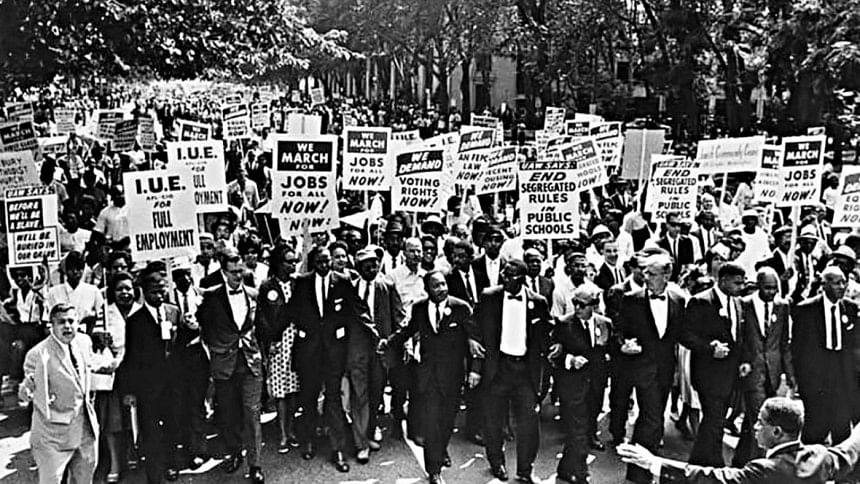Reviving civil disobedience

With populism and authoritarianism on the rise around the world, there has been considerable talk of "resistance," especially in the United States. A rather broad term, resistance could refer to everything from supporting opposition candidates to the life-threatening work of those who went underground to sabotage Nazi occupations during World War II. Such vagueness is helpful, if one wants to appeal to as many citizens as possible; but it can also cloud one's thinking when weighing how best to achieve concrete goals.
As it happens, there is a more precise alternative to "resistance" that is rarely mentioned nowadays: civil disobedience. In theory, civil disobedience should be an effective weapon against populists. But, in practice, it faces two formidable challenges. First, there is a widespread misunderstanding of what civil disobedience actually entails. And, second, changes in the media landscape have made it harder to convey the message of civil disobedience to a broad and diverse audience.
The American philosopher John Rawls offered the classic definition of civil disobedience in the early 1970s. Simply put, it means overt law-breaking, but in a conscientious, nonviolent manner aimed at persuading fellow citizens that a law ought to be changed because it is unjust. In Rawls's formulation, those who commit acts of civil disobedience should be prepared to accept the penalties for doing so.
Today, even protests that do not break any laws are often decried as "uncivil" or too "divisive" for an already polarised society. When citizens confronted politicians during US Supreme Court Justice Brett Kavanaugh's confirmation hearings, they were derided as a "mob". Even fellow liberals have admonished the Black Lives Matter movement for being too aggressive. And the noisy demonstrators who have gathered in Budapest to protest against Prime Minister Viktor Orbán's increasingly authoritarian government have been dismissed as "liberal anarchists". In each case, the "civil" in civil disobedience has been conflated with civility, as in politeness or general respectability.
For his part, Rawls was adamant that any law-breaking be undertaken "within the limits of fidelity to the law." He was echoing Martin Luther King, Jr, who argued that one who breaks the law in the name of civil disobedience "is in reality expressing the very highest respect for the law," by highlighting its fundamental injustice in such a way as not to foreclose on future cooperation with one's fellow citizens. Thus, King believed that, "one who breaks an unjust law must do so openly, lovingly, […] and with a willingness to accept the penalty."
That invocation of love should not be taken to mean that civil disobedience must be non-confrontational. A highly sanitised and sentimental historical accounting of the 1950s and 1960s might seem to suggest that the civil-rights movement succeeded merely by appealing to arch-American political principles of freedom and equality. In reality, part of the movement's strategy was to seek out confrontations with police and defenders of white supremacy. These clashes generated images of white brutality that made at least some whites reconsider their unconditional defence of "law and order" under Jim Crow.
In a recent study of protest movements spanning more than a century, social scientists Erica Chenoweth and Maria J Stephan show that tough but nonviolent confrontation has been twice as likely as violent alternatives to bring about its stated goals. According to their data, sustained participation by a mere 3.5 percent of a population can be enough to achieve fundamental political change.
Yet the history of the US civil-rights movement also points to a novel problem in our age. Rawls, King, and other defenders of civil disobedience took it for granted that the message—an appeal to principles of justice—would reach a majority of citizens undistorted. But today, the public spheres in many countries have become so fragmented and partisan that King's idea of "national opinion" now seems nonsensical.
As a recent groundbreaking study by three Harvard University scholars shows, the US has become home to a deeply insular "right-wing media ecosystem" in which all "news" is immediately reframed to confirm the identity of right-leaning citizens. And in semi-authoritarian contexts like Orbán's Hungary, media are now completely dominated by government-friendly actors. Under such conditions, most appeals to what Rawls called a "public sense of justice" will be sidelined, severely distorted, or silenced altogether.
Accordingly, potential practitioners of civil disobedience should not allow themselves to be caught in a trap of politeness and respectability. When opposition politicians recently disrupted the proceedings of the Hungarian parliament by blocking access to the speaker's podium and heckling Orbán to his face, they were accused of attempting a putsch. In fact, they were merely shining a spotlight on the fact that the national assembly is no longer a normal representative body passing legitimate laws.
Still, aspiring disobeyers will have to account for the increasingly fragmented and polluted nature of the public sphere. Sometimes, that will mean engaging fellow citizens directly on the street, in the marketplace, or even through door-to-door canvassing. In other situations, it will mean live-streaming acts of civil disobedience and hoping that authoritarians' brutal methods will be exposed to a large enough audience through social media. And on still other occasions, it will mean pushing for structural changes, such as a return to the Fairness Doctrine by broadcasters in the US.
Civil disobedience would certainly be more effective in a less distorted media landscape. But it still represents one of the most effective forms of democratic "resistance" available.
Jan-Werner Mueller is Professor of Politics at Princeton University. His latest book is What is Populism?
Copyright: Project Syndicate, 2018.
www.project-syndicate.org
(Exclusive to The Daily Star)





Comments